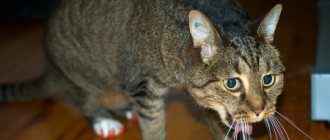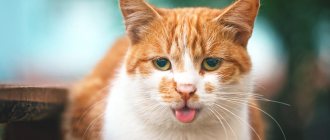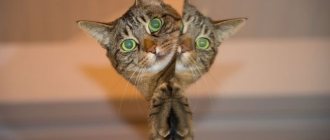Diseases of the digestive system and gastrointestinal tract in general are always a strong blow to the animal’s body. Diseases are further complicated by the fact that the same symptoms coincide with a large number of completely different diseases, which also need to be treated differently. Banal diarrhea, vomiting or severe diarrhea can indicate any of the diseases, which is why diagnosis should only be carried out by an experienced veterinarian who has already encountered many diseases and knows what to do in a given case. The most important thing is to never engage in diagnosis and treatment yourself, as this will often only make the situation worse. Likewise, coronavirus gastroenteritis in cats cannot be neglected and ignored.
Only an experienced doctor can make a clear and correct diagnosis, but do not rush to take your cat to the veterinary center yourself! Ours provides the service of calling a veterinarian to your home. This is not only convenient and will help you plan your time (after all, the doctor arrives in less than an hour at any time of the day), but it is also useful for your pet.
Cats often experience a lot of stress when moving to a new place, which is what the clinic serves. Stress
, especially during the period of illness, it greatly weakens the cat, affects its immunity in a negative way and spoils its condition. Our doctor will treat the disease professionally, quickly diagnose and prescribe a course of treatment.
In this article we will talk about infectious gastroenteritis, but remember that all information is for informational purposes only
.
Diagnosis should be carried out by a professional, so if you detect the slightest symptoms, call a veterinarian at home
!
About coronavirus gastroenteritis in cats
In general, coronavirus gastroenteritis in cats has several names, which mean the same thing. Thus, coronavirus gastroenteritis of cats is otherwise called feline viral peritonitis or coronavirus infection . All felines are susceptible to the disease: pets of any breed, as well as wild cats. It is common to refer to diseases with the letters FIP, an English abbreviation that shortens the long and complex English spelling of infection - Feline Infectious Peritonitis.
Like any other infection, the disease may not manifest itself for a long time.
.
Thus, the cat is a carrier of the virus until the infection causes weakness in the body and a gap in the immune system. This is the so-called incubation period. It is sometimes accompanied by periodic diarrhea and diarrhea. If diarrhea becomes more constant
, then you should pay attention to this and consult a veterinarian. If the disease is not treated and allowed to motivate, then death is also likely.
- In total, the disease has two main forms, which coincide in their components with most other diseases:
- Acute gastroenteritis.
- Chronic gastroenteritis.
Coronavirus gastroenteritis in cats: standard mode of transmission
disease itself , which is caused by a special virus. It enters the pet’s body through the cat’s respiratory functions, for example, when sniffing an infected object, or through the mouth during, for example, eating or licking
. This is also called oral and nasal. Thus, the virus enters the body and begins to develop and gain strength. If it enters the body directly through the gastrointestinal tract, then at the beginning of the disease the infection will invade the intestines and its epithelium; if through the nasal route, then the epithelium of the respiratory tissues in the upper part will be infected.
The disease varies and is divided into different strains
, which we will mention later, but in any case, most often the disease is quite contagious. As doctors say, the disease has a high degree of virulence. Especially if the animal lives in a nursery, shelter or animal hotel. The infection is transmitted from one animal to another.
Coronavirus infection in kittens
It is worth saying that a pregnant cat is not able to infect her child in the womb
, because her antibody helps the cat’s immunity, which means that he will not get sick.
However, after birth, the immune system only develops for the first 6-8 weeks
, so at this age
it is worth taking special care of the animal
and isolating it from other animals, just in case.
Coronavirus gastroenteritis in cats: transmission by other routes
The risk of transmitting the disease after, for example, stroking another pet is quite low. The disease is transmitted only through direct contact with another animal or through contact with the feces of these same animals.
. Therefore, you should limit your pets from communicating with suspicious cats, especially if they are yard or stray cats.
It is also worth remembering that coronavirus does not pose a danger to humans . Also, dogs or other pets are not susceptible to the disease, only cats of all genders and breeds.
How to treat?
As for medications used in the treatment of gastroenteritis, especially if it occurs in purulent or hemorrhagic forms, or is infectious in nature, then all prescriptions should be made only by a veterinarian.
Attention!
You should absolutely not treat gastroenteritis on your own, since this disease can cause extremely serious complications and, if treated incorrectly, can result in death.
Virus strains and their danger - coronavirus gastroenteritis in cats
In total, there are main groups of strains, which include viral peritonitis :
Coronavirus gastroenteritis in cats: intestinal strain
Intestinal strain or otherwise intestinal coronavirus , if we talk about the abbreviation that is used all over the world, it is FECV, which translates as Feline Enteric Coronavirus. All cats of all breeds, genders and sizes are susceptible to the disease throughout the world, but the specific infection has a low pathogen, which means that it is not so easy to provoke the disease. If the virus enters the body through breathing or through the mouth, then it can either linger in it or simply leave it asymptomatically after some time.
Of course, the pet’s immunity affects the behavior of the virus. After all , if the cat’s immunity and health are in good condition
, which means the virus and infection are recognized by cells of the immune system and removed by them.
If the body is weak
, the pet is restless and is haunted by stress, or is simply sick, then the body does not have the strength to fight, which means the infection begins to act and gain momentum. The disease manifests itself in the form of diarrhea and diarrhea, which has varying degrees of severity; in particular, it is worth paying attention to the common phenomenon of blood in the pet’s stool. It can be either large impurities or just mucus. Although the cat appears to be absolutely healthy.
- Symptoms and clinical signs will be presented below, but specifically for Feline Enteric Coronavirus, the symptoms are as follows:
- The gastrointestinal tract is inflamed and painful.
- Diarrhea.
- Impurities of blood and mucus in the animal's feces.
- Sometimes nausea.
All these symptoms are uncontrollable
, therefore, in this condition, transporting an animal to the clinic and back is extremely difficult, even when using your own car. That is why we provide a veterinarian home call service. Having many reference points in Moscow and the Moscow region, we confidently declare that the veterinarian will arrive within an hour, and 24 hours a day. A course of treatment and prevention will be determined immediately.
Coronavirus gastroenteritis in cats: infectious peritonitis virus
Next comes the strain that causes infectious peritonitis in pets, or otherwise the infectious peritonitis virus . What is known to doctors around the world is Feline Infectious Peritonitis Virus, or FIPV for short. If we talk about differences from FECV, then it has a high degree of pathogenicity and in almost all cases a fatal outcome is most likely, but the contagiousness is quite low. This means that even though the pet is very sick and will most likely die without proper treatment and the slightest delay, other pets will not be infected even in close proximity and contact with their relatives.
Feline Infectious Peritonitis Virus and Feline Enteric Coronavirus are inextricably linked with each other, because the first is a mutation of the intestinal coronavirus strain . However, if the intestinal coronavirus lives and exists only in epithelial tissues, then the mutation of the feline peritonitis infection infects the immune system and its cells
(their function and duty is to protect the body and absorb cells and particles that should not be there), and then spreads to the entire body, affecting organs and various systems. Capable of striking both partially and completely.
- Also distinguished two clinical types of the disease, which depend on the voltage of the immune system:
- Dry – develops slowly.
- Effusion – develops quickly and rapidly.
Since the disease can affect a large number of organs
, symptoms can also vary. Only an experienced veterinarian using special equipment can determine with the greatest probability why a particular organ hurts.
In the greatest number of cases, the disease develops in the presence of anxiety and stress in the pet’s life, into a state of depression and fear. Therefore, when moving or when guests arrive, you should try to talk to the animal kindly. You cannot shout at your pet, because this can also start a chain reaction and cause a disease, which is quite difficult to treat and the consequences of which are not the most favorable if it is missed and detected only in the last stages of development.
Do not delay treatment; at the first symptoms, which we will talk about later, immediately contact your veterinarian. He will certainly help and prescribe individual treatment for the cat. We will also talk further about the treatment of the disease, but there is still no one hundred percent guarantee that gastroenteritis will be cured, especially when it comes to the last stages.
General characteristics and key aspects:
- There is a great variety of gastroenteritis in small domestic animals, and it is not always possible to determine the cause of the condition. Minimum set of tests: TCA, total protein, blood glucose, acid-base and electrolyte composition of the blood.
- Clinical signs of acute gastroenteritis typically include vomiting, diarrhea, and partial or complete refusal to feed.
- Findings on physical examination are usually nonspecific: abdominal pain, dehydration, hypovolemia.
- If the cause of the disease is unknown, symptomatic therapy is prescribed. The prognosis for most cats and dogs with gastroenteritis is excellent.
Coronavirus gastroenteritis in cats: clinical signs
The danger of the disease is that it does not cause severe discomfort to pets, especially at the beginning.
.
Attacks of diarrhea or vomiting mixed with mucus or blood are often reduced to simple poisoning or indigestion, because throughout the next week, for example, the disease does not recur, and the pet does not give any signals that something is hurting. Blood and mucus in the stool is formed because the infection destroys the epithelial tissue in the intestines and inflames it.
Also, the danger of the disease lies in
its long incubation period. After all, when infected, a cat can carry the disease within itself for almost its entire life, and the infection waits for the moment of weakness of the immune system and the body, striking at the most unexpected moment, even in old age. Therefore, the cat most often feels well, unless it is weakened and the intestinal form of the infection mutates into the feline peritonitis virus.
The disease affects completely different organs of the animal, therefore the overall picture of the disease is completely different and individual. This is also a feature of the fact that you cannot treat your pet yourself.
, because without diagnosis and research it is impossible to say what exactly hurts and what should be emphasized.
However, in any case, if a pet is sick with viral peritonitis, then she will have a fever, low temperature, apathy, lack of appetite, lethargy and just general weakness. Kittens suffer from problems with growth and coat condition. Due to diarrhea and vomiting, which sometimes occurs frequently, the cat may be dehydrated .
Dry form of peritonitis - coronavirus gastroenteritis in cats
There is a dry form of peritonitis , which only a doctor can detect using an ultrasound of the pet’s abdomen. Symptoms include increased lymph and damage to the nervous system. The dry form can last for a cat for about several months, and the mortality rate here, unfortunately, reaches almost one hundred percent.
.
- Worth mentioning main signs of the dry form of infection:
- High body temperature.
- Severe dehydration due to vomiting and diarrhea, which also causes severe loss of body weight.
- The pet refuses to eat.
- Apathy, reluctance to play.
Wet form of peritonitis - coronavirus gastroenteritis in cats
There is also a wet form of the disease , in which the chest and abdomen of the animal become inflamed, fluid accumulates in these areas, and they, in turn, develop respiratory failure.
- It also has certain symptoms, which differ from the dry form:
- Fever and chills.
- Decreased appetite.
- Diarrhea and severe diarrhea.
- Reluctance to play and communicate, sometimes aggression.
- The abdominal cavity increases.
- Respiratory failure.
- Heart failure.
- Difficulty lying down, as fluid has accumulated in the abdomen and sternum, requiring removal.
Treatment of peritonitis.
There are no specific anti-coronavirus drugs. Specific serums are not yet available.
The dry form is much more treatable, but is much more difficult to diagnose, since the symptoms are often very similar to those of other diseases. Treatment is often aimed at regulating the immune response to the virus. Immunosuppressive therapy is usually used using glucocorticoid drugs. Large doses of corticoids provide short-term relief. But a pronounced immunosuppressive effect with long-term use, in most cases, causes a stable deterioration in the patient’s general condition, which is associated with inhibition of cellular immunity.
If gastroenteritis occurs, symptomatic treatment is carried out.
When a secondary infection develops, antibiotics are used.
According to some reports, a regimen was effective that combined injections of fosprenil in parallel with symptomatic treatment: sulfocamphocaine, antibiotics, gamavit, and the herbal medicine “Protection against Infections.”
Peritonitis in cats
Wet form of coronavirus peritonitis:
It is necessary to start treatment as early as possible, subject to the feeding regime and hygiene of the sick animal. In this case, it is impossible to use immunostimulants at this moment, especially interferons; the use of recombinant interleukins (roncoleukin, betaleukin) is allowed, but in the initial stage of the disease this is also undesirable.
The presence of a large amount of fluid in the abdominal (or chest) cavity threatens the animal with suffocation. To alleviate the general condition of the animals, punctures are performed and accumulated exudate is removed. Unfortunately, this manipulation only brings a temporary effect - the effusion accumulates again quite quickly. At the same time, diuretics are used in therapeutic doses, but very carefully, since their use can dehydrate the body, but does not in any way affect the ascites fluid. Drips or subcutaneous infusions are also not recommended, and only very small amounts of subcutaneous fluid are allowed in cases of severe dehydration. To suppress pathogenic microflora, antibiotics are prescribed under the supervision of a veterinarian. It is advisable to use prednisolone and other glucocorticoids in therapeutic doses.
Symptomatic treatment should include various vitamins, especially groups B and C, and multivitamin preparations. The dose and course of treatment should be prescribed by a veterinarian.
Unfortunately, not every body responds to treatment and begins to resist, developing its own defense.
In case of chronic course or carriage, specific treatment is not prescribed. The animal is monitored. In group housing conditions, it is advisable to isolate an animal that has been diagnosed with coronavirus and not use it for breeding.
IPK: pathology in animals
When opening animals with effusion IPC, the presence in the abdominal cavity of a large amount of yellow or dirty-gray liquid, transparent or with fibrin flakes. Similar fluid in the pleural cavity. The surface of the serous membranes often has greyish-white deposits of fibrin, and the omentum is dark, thickened and granular. Granulomatous changes in the form of white foci are clearly visible on sections of internal organs.
With dry IPC, there is either no ascites fluid in the abdominal cavity or its amount is extremely small, but granulomatous changes in the organs are identical to effusion IPC, however, more often with a much larger diameter, especially in the liver and kidneys.
Diagnosis of disease and infection coronavirus gastroenteritis in cats
Of course, in order to correctly diagnose a disease with such complex symptoms, it is necessary to conduct a comprehensive and detailed examination of the body, studying abnormalities in each organ. Ultrasound and x-rays of individual parts and organs are performed. If the animal died, a pathological autopsy is performed.
A laboratory test is also carried out , which requires examining blood, feces, smears and rectal rinses. Flushes are also taken from the abdominal cavity and chest cavity. After examining the washings and feces using PCR, the presence of intestinal coronavirus is determined. Blood and effusion are also tested for the presence of pet peritonitis using PCR or ELISA testing. It is worth understanding that it also happens that the peritonitis virus and intestinal disease often occur simultaneously, and if this form of the disease is not recognized in time, treatment becomes even more difficult, and sometimes even leads to death.
When determining the disease using ultrasound, it is the intestines and its inflammation that are often noted, as well as the presence of fluids; some organs change their structure, most often the liver, kidneys, spleen, and deposits also occur in the sternum and abdomen. Lymphs increase.
Treatment of coronavirus gastroenteritis in cats, as well as its prevention
If the pet has a strong immune system and is also healthy and in good physical shape, veterinarians can identify the disease using the means described above. If an infection is identified during the incubation period, this does not mean that it does not need to be treated. After all, at any moment the body can give way, which means the infection will begin its work immediately, which often leads to death. In this case, experienced veterinarians prescribe an operation to naturally remove the virus , which is called elimination .
In total, the operation lasts about two to three weeks.
, in some cases longer and reaches several months.
The coronavirus itself is no longer dangerous for the pet after the procedures, however, it will still persist in the feces, which means there is a risk of infecting other cats, so you should be careful and if there are several pets living in the house, you need to clean the litter box more often and monitor its sterility. It is also worth observing general hygiene and disinfecting places
with which the virus carrier interacts.
There are no drugs that can cure the disease completely, one hundred percent.
. Doctors can only guarantee the cat’s overall quality of life, as well as prevent the disease from developing to stages from which there is no way out. If a pet is affected by the intestinal coronavirus of gastroenteritis, then they are able to live until old age without any complications; moreover, an examination by a veterinarian over all these years is not even necessary, because the disease is asymptomatic.
If this is infectious peritonitis , then life after damage to the body may end after just a few months
. It all depends on the experience of the veterinarian and the stage at which the disease was detected. However, more often than not, veterinarians only promise to alleviate the condition for a while and the overall life expectancy is reduced several times. In general, the course of treatment depends on, as already mentioned, the stage of the disease and the general individual characteristics of the cat. After all, different organs are affected and have different consequences.
Coronavirus gastroenteritis in cats - prevention
- There are methods to save an animal before infection:
- Do not allow contact with a large number of animals, especially if they are homeless. Also, do not allow communication with unverified animals.
- Maintain hygiene.
- Avoid hypothermia and overheating of your pet.
- Monitor small kittens, especially young ones, especially carefully. Indeed, in the first months of life, immunity is only formed after leaving the mother’s womb, where it was safe from coronavirus gastroenteritis.
Recovery
The first thing to do if a cat develops gastroenteritis is, if possible, to eliminate the cause of the disease and establish proper nutrition:
- For the first two days, do not feed your pet anything at all.
- Later, give him low-fat beef broth and a decoction of herbs: sage, chamomile, St. John's wort, flaxseed, and a weak decoction of oak bark.
- On the fourth day, you can feed one boiled or raw egg three times a day; liquid oatmeal or rice porridge is also allowed, and you can add a little boiled chicken or minced beef to them.
- Then you can give fermented milk products, porridge with milk and vegetable soups.
- From the tenth day, if everything is normal, you can return to your pet’s normal diet.
- In case of coronavirus gastroenteritis, your pet should be fed light, well-digestible food. For example, you can give him boiled chicken or boiled lean fish. If the animal is too weakened by illness, then it is best to feed it only low-fat broths.
Important!
Diet for any gastroenteritis is of primary importance for recovery. Therefore, it is necessary to feed a cat with this disease only those foods that are allowed and in no case give it prohibited treats.
Anatomy and physiology
The stomach is a section of the gastrointestinal tract between the esophagus and the small intestine, which serves as a storage reservoir for food, and also grinds and mixes food here, which then enters the small intestine. The stomach consists of muscle layers, areas of glandular tissue and mucous membrane. With the help of muscle movements, the stomach grinds food and pushes it through the pyloric sphincter into the small intestine. The glandular areas are no less important: the parietal cells secrete hydrochloric acid, the main cells secrete pepsinogen, and the mucus-forming cells also secrete bicarbonate. Due to the barrier function of the gastric mucosa, hydrochloric acid and digestive enzymes are retained in the lumen of the stomach, which prevents the loss of plasma components into the stomach. Once the food in the stomach is sufficiently crushed, it moves through the pyloric sphincter into the small intestine, the beginning of which is called the duodenum.
The small intestine of cats and dogs is divided into the duodenum, jejunum and ileum. The mucous membrane of the small intestine performs both secretory and absorption functions and consists of a monolayer of cells - enterocytes. The mucous membrane of the small intestine along its entire length forms finger-like villi that protrude into the intestinal lumen and increase its working surface. Microvilli form a “brush border”, which further increases the surface area for better digestion and absorption of nutrients.
Brush border enzymes break down larger molecules into smaller ones that are more easily absorbed. Absorption usually occurs through special transport mechanisms or pinocytosis. Epithelial cells are also involved in the absorption and secretion of water and electrolytes. Enterocytes are tightly connected to each other to limit absorption between cells and prevent the reverse flow of nutrients - from the interstitium into the intestinal lumen. The lifespan of enterocytes ranges from 2 to 5 days; they start from the crypts (the base of the villi) and migrate towards the intestinal lumen. A healthy, intact mucous membrane plays a large role in maintaining the integrity of the intestines. Any inflammation that disrupts the integrity of the mucosa can lead to serious intestinal disease. It is important to remember that the gastrointestinal tract absorbs 99% of the water entering it, therefore, any disturbances in the functioning of the gastrointestinal tract can lead to serious disorders of the water and electrolyte balance of the body.
Prevention
- A correct and complete diet, alternating between dry and wet premium or super premium food.
- You should not give your cat salty, spicy or smoked foods, as well as food that is not typical for carnivores - sweets, too fatty or smoked.
- Buying high-quality food, avoiding spoiled or contaminated foods in the diet.
- Feeding 2 to 4 times a day.
- When changing food, the new one should be introduced gradually, starting with a small amount of the new type of food per day.
- Do not mix industrial and natural feed.
- Regular use of vitamins (courses every six months)
- Preventive deworming – for domestic cats once a year, for those with access to the street – 2 times a year.
Causes
Feline gastroenteritis occurs for the following reasons:
- Traumatic injury when swallowing hard objects - fish bones, small toys.
- Formation of trichobezoars from hairs swallowed during licking. Long-haired cats are primarily affected.
- Sudden change of food.
- Eating food from the hosts’ table - fried, salty, smoked, sweet.
- Mixing dry granulated food with natural products.
- Poisoning by mice caught during deratization with anticoagulants.
- Complications of chronic non-communicable diseases.
- Side effects of medications.
- Contagious diseases of infectious or parasitic etiology.
- Formation of tumors.
Good to know
- Hematemesis in dogs and cats
- What are the main causes of protein-losing enteropathy in dogs?
- Main causes of chronic colonic diarrhea in dogs and cats
- How to distinguish chronic small intestinal diarrhea from large intestinal diarrhea?
- Causes of malabsorption in dogs
- Vomiting in cats and dogs
- Causes of acute diarrhea in dogs and cats
- Canine distemper in dogs (forms, diagnosis, symptoms, treatment, therapy)
- Esophagoscopy in dogs and cats
- Protein wasting intestinal disease in dogs. Enteropathy in dogs
- Treatment of hyperlipidemia in dogs with Bezafibrate
- Vomiting, regurgitation in dogs and cats
- Small intestinal transient disorders
- Diseases of the anus and rectum in dogs and cats
- Cholangitis in cats. Identifying, diagnosing and treating cats with neutrophilic, bacterial, lymphocytic or chronic cholangitis
- Diarrhea in dogs and cats
- Canine exocrine pancreatic insufficiency
- Enteral nutrition for dogs and cats
- Protein-losing enteropathy. Protein enteropathy in dogs
- Lymphocytic cholangitis in cats
- Acute pancreatitis in dogs and cats
- Gastric volvulus in dogs
- Fat metabolism and hyperlipidemia in dogs











